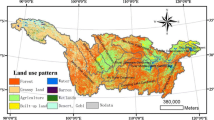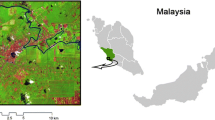Abstract
Land use optimization as a resource allocation problem can be defined as the process of assigning different land uses to a region. Sustainable development also involves the exploitation of environmental resources, investment orientation, technology development, and industrial changes in a coordinated form. This paper studies the multi-objective sustainable land use planning problem and proposes an integrated framework, including simulation, forecasting, and optimization approaches for this problem. Land use optimization, a multifaceted process, requires complex decisions, including selection of land uses, forecasting land use allocation percentage, and assigning locations to land uses. The land use allocation percentage in the selected horizons is simulated and predicted by designing a System Dynamics (SD) model based on socio-economic variables. Furthermore, land use assignment is accomplished with a multi-objective integer programming model that is solved using augmented ε-constraint and non-dominated sorting genetic algorithm II (NSGA-II) methods. According to the results of the SD model, land use changes depend on population growth rate and labor productivity variables. Among the possible scenarios, a scenario focusing more on sustainable planning is chosen and the forecasting results of this scenario are used for optimal land use allocation. The computational results show that the augmented ε-constraint method cannot solve this problem even for medium sizes. The NSGA-II method not only solves the problem at large sizes over a reasonable time, but also generates good-quality solutions. NSGA-II showed better performance in metrics, including number of non-dominated Pareto solutions (NNPS), mean ideal distance (MID), and dispersion metric (DM). Integrated framework is implemented to allocate four types of land uses consisting of residential, commercial, industrial, and agricultural to a given region with 900 cells.












Similar content being viewed by others
References
Basse R, Omrani H, Charif O, Gerber P, Bodis K (2014) Land use changes modelling using advanced methods: cellular automata and artificial neural networks. The spatial and explicit representation of land cover dynamics at the cross-border region scale. Appl Geogr 53:160–171
Basse R, Charif O, Bodis K (2016) Spatial and temporal dimensions of land use change in cross border region of Luxembourg. Development of a hybrid approach integrating GIS, cellular automata and decision learning tree models. Appl Geogr 67:94–108
Bisschop J (2006) AIMMS optimization modeling. Paragon Decision Technology B.V., Harlem
Bos J (1993) Zoning in forest management: a quadratic assignment problem solved by simulated annealing. J Environ Manag 37:127–145
Broere W (2016) Urban underground space: solving the problems of today’s cities. Tunn Undergr Space Technol 55:245–248
Cao K, Batty M, Huang B, Liu Y, Yu L, Chen J (2011) Spatial multi-objective land use optimization: extensions to the non-dominated sorting genetic algorithm-II. Int J Geogr Inf Sci 25(12):1949–1969
Cao K, Huang B, Wang S, Lin H (2012) Sustainable land use optimization using boundary-based fast genetic algorithm. Comput Environ Urban Syst 36:257–269
Chakir R, Le-Gallo J (2013) Predicting land use allocation in France: a spatial panel data analysis. Ecol Econ 92:114–125
Chen Y, Li X, Liu X, Liu Y (2010) An agent-based model for optimal land allocation (AgentLA) with a contiguity constraint. Int J Geogr Inf Sci 24(8):1269–1288
Christensen V, Ferdãna Z, Steenbeek J (2009) Spatial Optimization of Protected Area Placement Incorporating Ecological, Social and Economical Criteria. Ecol Model 220:2583–2593
Deb K, Pratap A, Agarwal S, Meyarivan T (2000) A fast elitist non-dominated sorting genetic algorithm for multi-objective optimization: NSGA-II. In: Proceedings of the parallel problem solving from nature VI conference, pp 849–858
Deb K, Pratap A, Agarwal S, Meyarivan T (2002) A fast and elitist multiobjective genetic algorithm: NSGA-II. IEEE Trans Evol Comput 6(2):182–197
Dugardin F, Yalaoui F, Amodeo L (2010) New multi-objective method to solve reentrant hybrid flow shop scheduling problem. Eur J Oper Res 203:22–31
Eldrandaly K (2012) A GEP-based spatial decision support system for multisite land use allocation. Appl Soft Comput 10:694–702
El-Haggar PESM (2007) Sustainable development and environmental reform. Sustainable industrial design and waste management, pp 125–148
Feng Y, Liu Y, Tong X, Liu M, Deng S (2011) Modeling dynamic urban growth using cellular automata and particle swarm optimization rules. Landsc Urban Plan 102:188–196
Galdavi S, Mohammadzadeh M, Mahiny AS, Nejad AN (2019) Comparison of logistic regression and geomod approaches to forest change modeling in the period of 1988–2025. Asian J Res Agric Forest 4(4):1–15
Holzkamper A, Seppelt R (2007) A generic tool for optimising land-use patterns and landscape structures. Environ Model Softw 22:1801–1804
Janssen R, van Herwijnen M, Stewart TJ, Aerts JC (2008) Multiobjective decision support for land-use planning. Environ Plann B Plann Des 35(4):740–756
Kai C (2010) Multi-objective land use optimization using genetic algorithm. Ph.D Thesis, Department of Industrial Engineering, the Chinese University of Hong Kong
Knoke T, Paul C, Härtl F, Maria-Castro L, Calvas B, Hildebrandt P (2015) Optimizing agricultural land-use portfolios with scarce data: a non-stochastic model. Ecol Econ 120:250–259
Liu X, Ou J, Li X, Ai B (2013) Combining system dynamics and hybrid particle swarm optimization for land use allocation. Ecol Model 257:11–24
Liu Y, Tang W, He J, Liu Y, Ai T, Liu D (2015) A land-use spatial optimization model based on genetic optimization and game theory. Comput Environ Urban Syst 49:1–14
Luo G, Yin C, Chen X, Xu W, Lu L (2010) Combining system dynamic model and CLUE-S model to improve land use scenario analyses at regional scale: a case study of sangong watershed in Xinjiang, China. Ecol Complex 7:198–207
Mavrotas G (2009) Effective implementation of the ε-constraint method in multi-objective mathematical programming problems. Appl Math Comput 213(2):455–465
Montgomery DC (2000) Design and analysis of experiments, 5th edn. Wiley, New York
Nabiuny E (2012) Calculation of productivity of production factors (workforce, land and capital) in the agricultural sector of Markazi province. Work Soc 141:67–79
Neuwirth C, Peck A, Simonovi S (2015) Modeling structural change in spatial system dynamics: a daisyworld example. Environ Model Softw 65:30–40
Porta J, Parapar P, Doallo R, Rivera F, Sante I, Crecente R (2013) High performance genetic algorithm for land use planning. Comput Environ Urban Syst 37:45–58
Sang L, Zhang C, Yang J, Zhu D, Yun W (2011) Simulation of land use spatial pattern of towns and villages based on CA-Markov model. Math Comput Model 54:938–943
Sante-Riveira I, Boullon-Magan M, Crecente-Maseda R, Miranda-Barros D (2008a) Algorithm based on simulated annealing for land-use allocation. Comput Geosci 34:259–268
Sante-Riveira I, Crecente-Maseda R, Miranda-Barros D (2008b) GIS-based planning support system for rural land-use allocation. Comput Electron Agric 63:257–273
Schweitzer C, Priess J, Das S (2011) A generic framework for land-use modeling. Environ Model Softw 26:1052–1055
Stewart TJ, Janssen R, van Herwijnen M (2004) A genetic algorithm approach to multiobjective land use planning. Comput Oper Res 31(14):2293–2313
Taguchi G (2000) Introduction to quality engineering. Asian Productivity Organization/UNIPUB, White Plains
Wang S, Wang X, Zhang H (2015) Simulation on optimized allocation of land resource based on DE-CA model. Ecol Model 314:135–144
Yao J, Zhang X, Murray AT (2017) Spatial optimization for land-use allocation: accounting for sustainability concerns. Int Reg Sci Rev 41(6):579–600
Yoon EJ, Lee DK, Kim HG, Kim HR, Jung E, Yoon H (2017) Multi-objective land-use allocation considering landslide risk under climate change: case study in Pyeongchang-gun, Korea. Sustainability 9(12):2306
Zhang Y, Zhang H, Ni D, Song W (2012) Agricultural land use optimal allocation system in developing area: application to Yili watershed Xinjiang Region. Chin Geogr Sci 22(2):232–244
Zhang H, Zeng Y, Jin X, Shue B, Zhou Y, Yang X (2016) Simulating multi-objective land use optimization allocation using multi-agent system. A case study in Changsha, China. Ecol Model 320:334–347
Author information
Authors and Affiliations
Corresponding author
Appendix 1: Equations in SD
Appendix 1: Equations in SD
Other equations are used in the proposed system dynamics are as follows:
Equation (35) is used to formulate the phenomenon of migration. This equation is based on the assumption that immigrating to city occurs when there is one of two conditions: (1) there is a vacancy for population and (2) there is vacancy for employment. On this basis, if the maximum available capacity for population and employment is greater than the current population, immigration to the city will occur. The negative value of the PC parameter means that (1) the city does not have the capacity of the current population; and (2) the city does not have the capacity of employment for the current population. Accordingly, a number of people are migrating from the city.
Rights and permissions
About this article
Cite this article
Ramezanian, R., Hajipour, M. Integrated framework of system dynamics and meta-heuristic for multi-objective land use planning problem. Landscape Ecol Eng 16, 113–133 (2020). https://doi.org/10.1007/s11355-020-00410-1
Received:
Revised:
Accepted:
Published:
Issue Date:
DOI: https://doi.org/10.1007/s11355-020-00410-1




